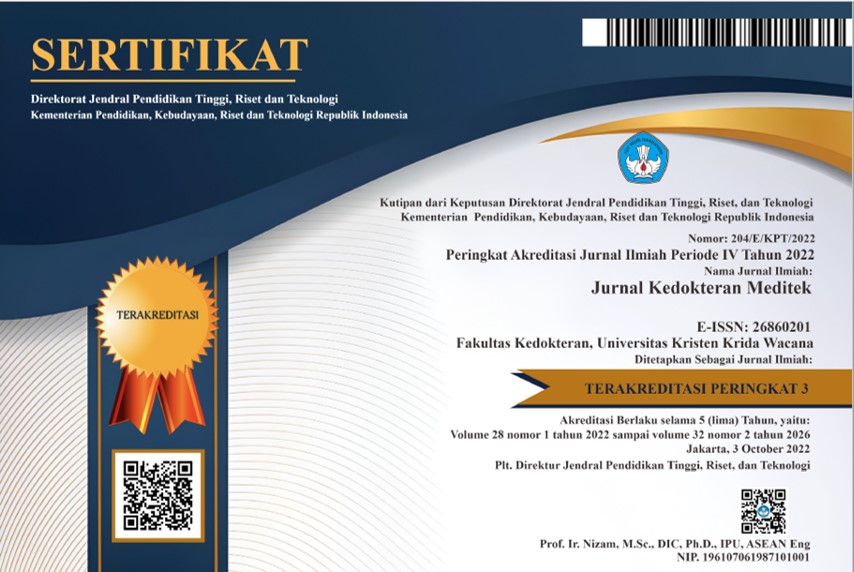Gambaran Risiko Kejadian Carpal Tunnel Syndrome pada Karyawan Administrasi Universitas Kristen Krida Wacana
DOI:
https://doi.org/10.36452/jkdoktmeditek.v26i2.1845Keywords:
administration staff, carpal tunnel syndromAbstract
Carpal Tunnel Syndrome (CTS) is a neurological disorder on upper extremities in which the medianus nerve is impinged. Carpal tunnel entrapment can be caused by multiple causes. One of the most common cause is job-related activities of repeated flexion and extension of wrist such as in typing activity. This study aimed to describe the incidence of CTS in university administrative employees. This was a cross-sectional study conducted at Krida Wacana University in 2019. Twenty-nine respondents were included in the study by a purposive sampling. Subjects filled out questionnaires describing troubling symptoms, age, gender, typing duration per day, work period, wrist position, and Phalen’s test to assess CTS incidence. Data were analysed with SPSS 23 software. Incidence risk for CTS was found in respondents from various age groups (40-60 years old), with 11 (37.9%) respondents were CTS-risk, and 16 respondents were CTS-positive. Eighteen respondents with typing duration of > 4 hours/day was found to be at risk for CTS. Of respondents group with odd wrist position, 16 (55.2%) of them were at risk to suffer CTS. The study concludes that the incidence of CTS in administrative employee increases with advancing age, working duration, and awkward hand position while working. Thus, education is required for the administrative employees about factors causing CTS risks.
References
2. Moore KL, Dalley AF, Agur AM. Clinically oriented anatomy. 8th ed. Philadelphia: Wolters Kluwer, 2018.
3. Snell RS. Clinical anatomy. 4th ed. Balimore: Lipincott, 2004.
4. Dale A, Harris-Adamson C, Rempel D, Gerr F, Hegmann K, Silverstein B, et al. Prevalence and incidence of carpal tunnel syndrome in US working populations: pooled analysis of six prospective studies. Scandinavian Journal of Work, Environment & Health. 2013;39(5):495-505.
5. Burke F. Primary care management of carpal tunnel syndrome. Postgraduate Medical Journal. 2003 [disitasi 6 April 2018];79(934):433-37. Tersedia dari:http://pmj.bmj.com/content/79/934/433
6. Lusianwati TD. Peran latihan tangan dalam pencegahan carpal tunnel syndrome pada wanita pekerja garmen. Jurnal ekologi kesehatan. 2018;11(2).
7. Fitriani RN. Faktor-faktor yang berhubungan dengan dugaan carpal tunnel syndrome (CTS) pada operator komputer bagian sekretariat di Inspektorat Jenderal Kementrian Pekerjaan Umum. Jakarta: Universitas Islam Negeri Syarif Hidayatullah, 2012.
8. Ilyas MF. Hubungan usia dan masa kerja dengan posisi pergelangan tangan terhadap carpal tunnel syndrome pada supir bajaj di Jakarta Barat. Jakarta: Universitas Muhammadiyah Jakarta, 2015.
9. Meagan S, Melissa B. Work related risk factors for carpal tunnel syndrome. Accident Compensation Coorporation. 2014 [disitasi 15 Juni 2019]. Tersedia dari: https://www.acc.co.nz/assets/research/05944ee617/work-risk-carpal-tunnel.pdf
10. Bahruddin, Putra RL, Alief HF, dkk. Hubungan masa kerja dengan kejadian carpal tunnel syndrome pada pekerja pemetik daun teh. Malang: Fakultas Kedokteran Universitas Muhhamadiyah Malang, 2016.
11. Juniari GAR, Wahyudi AT. Hubungan antara masa kerja terhadap keluhan carpal tunnel syndrome pada pegawai perempuan di kampus Universitas Dhyana Pura yang bekerja menggunakan komputer. Jurnal Virgin 2015;1(2):162-8.
12. Setiawan AD, Winaya N, Muliarta. Hubungan posisi pergelangan tangan saat mengetik terhadap risiko terjadinya carpal tunnel syndrome (CTS) pada karyawan PT X. Denpasar: Fakultas Kedokteran Universitas Udayana, 2015.
13. Mallapiangi F, Wahyudi AA. Gambaran faktor pekerjaan dengan kejadian carpal tunnel syndrome (CTS) pada pengrajin batu tatakan di Desa Lempang Kec. Tanete Riaja Kabupaten Barru. Makassar: Al-Sihah-Public Health Science Journal. 2015;6(2):2.
14. Bickel KD. Carpal tunnel syndrome. JHS. 2010;35:147-52.
15. Aroori S, Spence RA. Carpal tunnel syndrome. Ulster Med J. 2008;77(1):6-17.
16. Arab AA, Elmaghrabi MM, Eltantawy MH. Carpal tunnel syndrome: evaluation of its provocative clinical tests. Egyption Jurnal of Neurosurgery.2019;33(14):1-4
17. Atroshi I, Gummesson C, Johnsson R, Sprinchorn A. Symptoms, disability, and quality of life in patients with carpal tunnel syndrome.1999;24(2):388-404
18. Mondelli M, Giannini F, Giacchi M. Carpal tunnel syndrome incidence in a general population. Neurology. 2002;58:289-93
19. Olney RK. Carpal tunnel syndrome: complex issues with a simple condition. Neurology. 2001;56:1431-2.
20. Foley M, Silverstein B, Polissar N. The economic burden of carpal tunnel syndrome: long term earnings of CTS claimant in Washington State. American Journal of Industrial Medicine. 2007;50:155-72.

















